Ephrin-B2 and EphB2 regulation of astrocyte-meningeal fibroblast interactions in response to spinal cord lesions in adult rats
- PMID: 12944508
- PMCID: PMC6740614
- DOI: 10.1523/JNEUROSCI.23-21-07789.2003
Ephrin-B2 and EphB2 regulation of astrocyte-meningeal fibroblast interactions in response to spinal cord lesions in adult rats
Abstract
The present study provides the first evidence that signaling occurs between B-ephrins and EphB receptors in the adult CNS in response to injury. Specifically, our combined histological and biochemical data indicate that two members of the B-class of ephrins and Eph receptors, ephrin-B2 and EphB2, are expressed by astrocytes and meningeal fibroblasts, respectively, in the adult spinal cord. In response to thoracic spinal cord transection lesions, ephrin-B2 and EphB2 protein levels exhibit an initial decrease (1 d after lesion), followed by a significant increase by day 14. Immunohistochemical data indicate that ephrin-B2 is expressed by reactive CNS astrocytes, and EphB2 is present on fibroblasts invading the lesion site from the adjacent meninges. During the first 3 d after injury, there is intermingling of ephrin-B2-expressing reactive astrocytes at the lesion surface with EphB2-containing fibroblasts that is concurrent with bidirectional activation (phosphorylation) of ephrin-B2 and EphB2. By 7 d, both cell types are establishing restricted cellular domains containing dense networks of cells and interweaving processes. This astroglial-meningeal fibroblast scar is fully developed by day 14 when there is strict segregation of ephrin-B2-expressing astrocytes from EphB2-positive meningeal fibroblasts. These morphological changes are concomitant with a simultaneous decrease in ephrin-B2 and EphB2 activation. These observations provide strong evidence that cell contact-mediated bidirectional signaling between ephrin-B2 on reactive astrocytes and EphB2 on meningeal fibroblasts is an early event in the cellular cascades that result in the development of the glial scar and the exclusion of meningeal fibroblasts from the injured spinal cord.
Figures
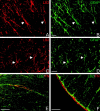

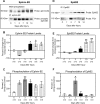
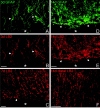
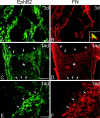
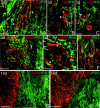
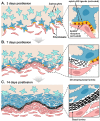
Similar articles
-
RNAi-mediated ephrin-B2 silencing attenuates astroglial-fibrotic scar formation and improves spinal cord axon growth.CNS Neurosci Ther. 2017 Oct;23(10):779-789. doi: 10.1111/cns.12723. Epub 2017 Aug 21. CNS Neurosci Ther. 2017. PMID: 28834283 Free PMC article.
-
Improved axonal regeneration after spinal cord injury in mice with conditional deletion of ephrin B2 under the GFAP promoter.Neuroscience. 2013 Jun 25;241:89-99. doi: 10.1016/j.neuroscience.2013.03.010. Epub 2013 Mar 19. Neuroscience. 2013. PMID: 23518227 Free PMC article.
-
Distribution of EphB receptors and ephrin-B1 in the developing vertebrate spinal cord.J Comp Neurol. 2006 Aug 10;497(5):734-50. doi: 10.1002/cne.21001. J Comp Neurol. 2006. PMID: 16786562 Free PMC article.
-
The Value of EphB2 Receptor and Cognate Ephrin Ligands in Prognostic and Predictive Assessments of Human Breast Cancer.Int J Mol Sci. 2021 Jul 28;22(15):8098. doi: 10.3390/ijms22158098. Int J Mol Sci. 2021. PMID: 34360867 Free PMC article.
-
Ephrin B/EphB in neuropathic pain: Role and molecular mechanisms.Fundam Clin Pharmacol. 2024 Feb;38(1):4-12. doi: 10.1111/fcp.12937. Epub 2023 Jul 3. Fundam Clin Pharmacol. 2024. PMID: 37401197 Review.
Cited by
-
Dopaminergic axon guidance: which makes what?Front Cell Neurosci. 2012 Jul 31;6:32. doi: 10.3389/fncel.2012.00032. eCollection 2012. Front Cell Neurosci. 2012. PMID: 22866028 Free PMC article.
-
Histamine promotes locomotion recovery after spinal cord hemisection via inhibiting astrocytic scar formation.CNS Neurosci Ther. 2015 May;21(5):454-62. doi: 10.1111/cns.12379. Epub 2015 Jan 24. CNS Neurosci Ther. 2015. PMID: 25620315 Free PMC article.
-
Col1a1+ perivascular cells in the brain are a source of retinoic acid following stroke.BMC Neurosci. 2016 Jul 15;17(1):49. doi: 10.1186/s12868-016-0284-5. BMC Neurosci. 2016. PMID: 27422020 Free PMC article.
-
A novel DNA enzyme reduces glycosaminoglycan chains in the glial scar and allows microtransplanted dorsal root ganglia axons to regenerate beyond lesions in the spinal cord.J Neurosci. 2004 Feb 11;24(6):1393-7. doi: 10.1523/JNEUROSCI.4986-03.2004. J Neurosci. 2004. PMID: 14960611 Free PMC article.
-
Conditional Deletion of EphA4 on Cx3cr1-Expressing Microglia Fails to Influence Histopathological Outcome and Blood Brain Barrier Disruption Following Brain Injury.Front Mol Neurosci. 2021 Sep 24;14:747770. doi: 10.3389/fnmol.2021.747770. eCollection 2021. Front Mol Neurosci. 2021. PMID: 34630039 Free PMC article.
References
-
- Abnet K, Fawcett JW, Dunnett SB ( 1991) Interactions between meningeal cells and astrocytes in vivo and in vitro. Brain Res Dev Brain Res 59: 187-196. - PubMed
-
- Berry M, Maxwell WL, Logan A, Mathewson A, McConnell P, Ashhurst DE, Thomas GH ( 1983) Deposition of scar tissue in the central nervous system. Acta Neurochir (Wien) [Suppl] 32: 31-53. - PubMed
-
- Bradbury EJ, Moon LD, Popat RJ, King VR, Bennett GS, Patel PN, Fawcett JW, McMahon SB ( 2002) Chondroitinase ABC promotes functional recovery after spinal cord injury. Nature 416: 636-640. - PubMed
-
- Bruckner K, Pasquale EB, Klein R ( 1997) Tyrosine phosphorylation of transmembrane ligands for Eph receptors. Science 275: 1640-1643. - PubMed
-
- Bruckner K, Pablo Labrador J, Scheiffele P, Herb A, Seeburg PH, Klein R ( 1999) EphrinB ligands recruit GRIP family PDZ adaptor proteins into raft membrane microdomains. Neuron 22: 511-524. - PubMed
Publication types
MeSH terms
Substances
Grants and funding
LinkOut - more resources
Full Text Sources
Miscellaneous
